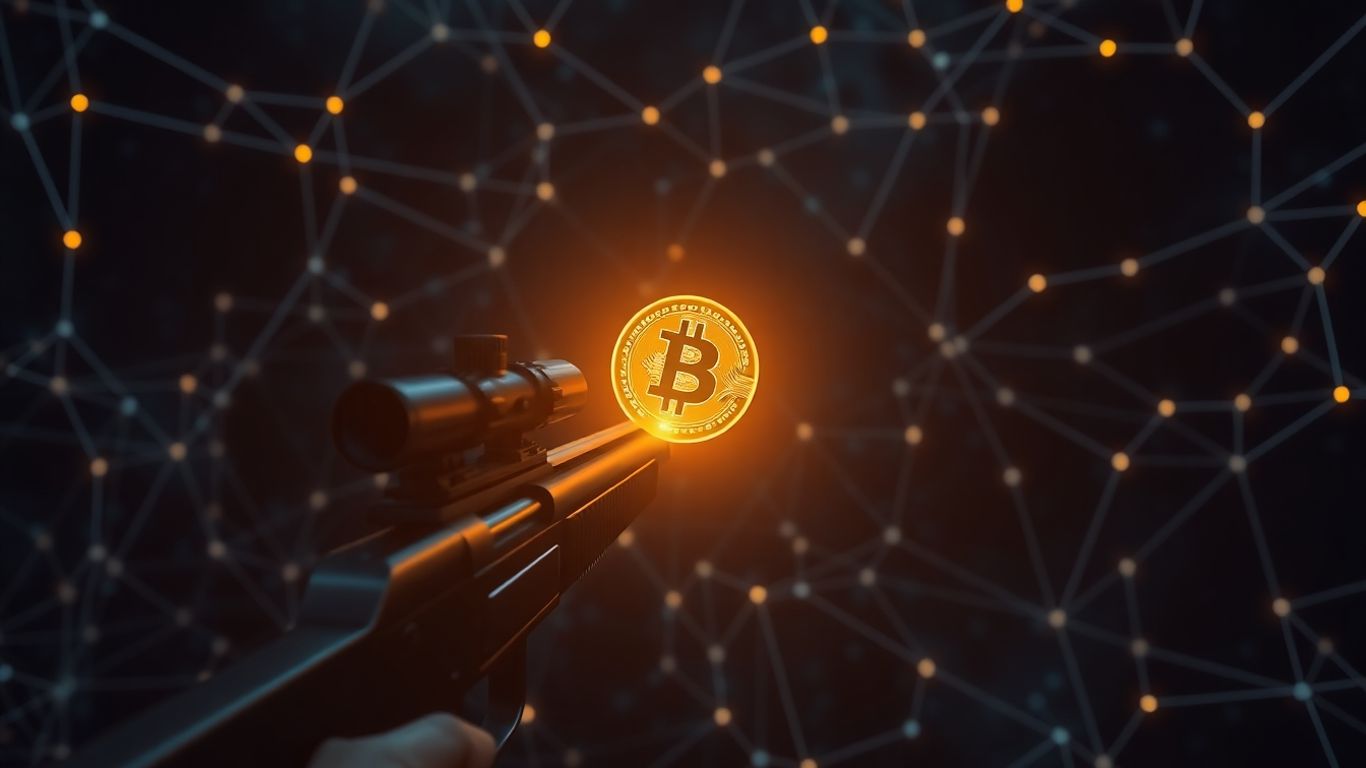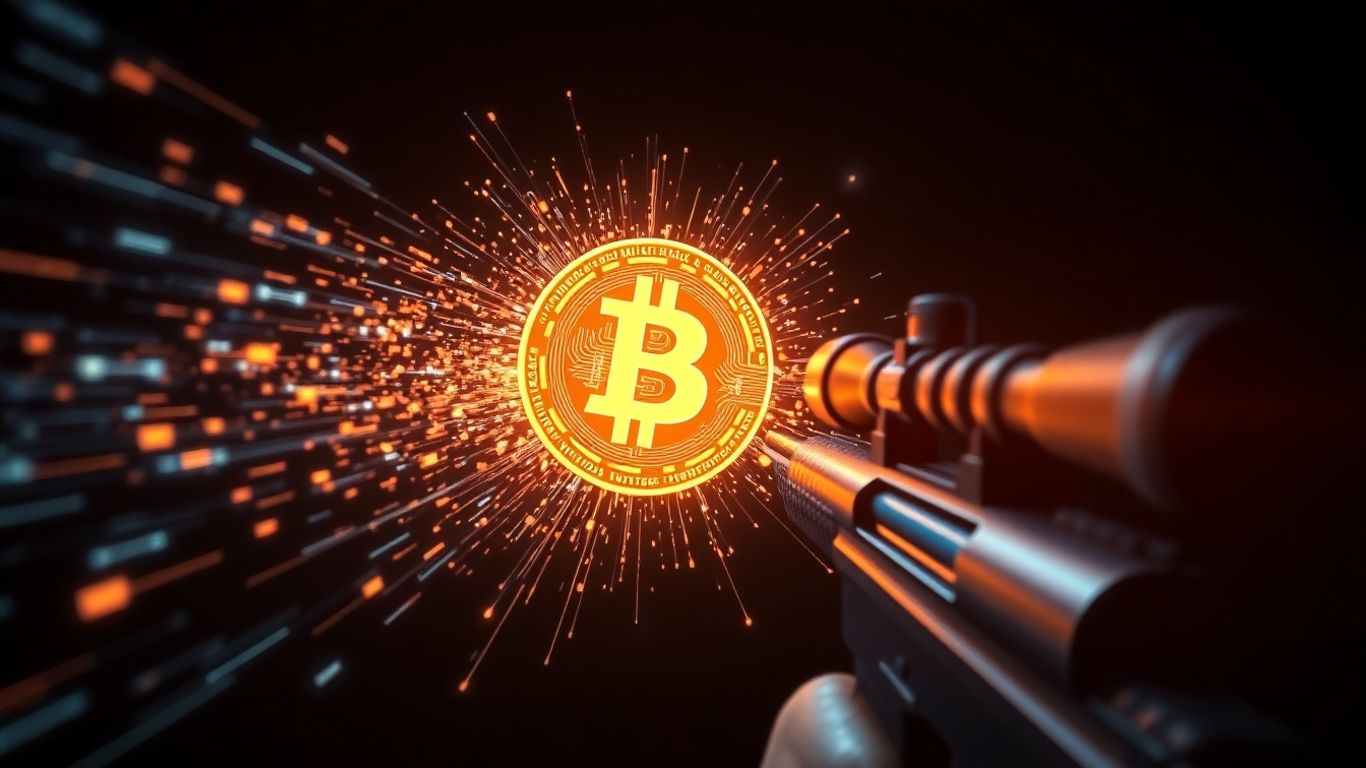[ newsletter ]
Stay ahead of Web3 threats—subscribe to our newsletter for the latest in blockchain security insights and updates.
Thank you! Your submission has been received!
Oops! Something went wrong. Please try again.
Learn what is sniping in crypto, a high-speed trading strategy using bots to capitalize on market inefficiencies and token launches. Understand the risks and impact.





In the fast-paced world of cryptocurrency, making a profit often comes down to pure speed. You might have heard the term 'sniping' thrown around, and it's basically about getting in and out of trades super fast to catch quick gains. Think of it like a sniper in a game, waiting for the perfect moment to strike. This strategy uses bots to watch the market and act before anyone else can. It's popular for new token launches or when prices move unexpectedly. But like anything in crypto, it's not all smooth sailing. There are definite risks involved.
So, what exactly is this "sniping" thing in the crypto world? Basically, it's a trading strategy. Think of it like a sniper in a game – they aim for a quick, precise strike to get an advantage. In crypto, this means traders use automated tools, often called bots, to jump into the market and make trades at super high speeds. They're not just casually browsing; they're actively looking for tiny windows of opportunity, usually when a new token is just launching or when there's a quick price difference they can exploit. The whole point is to get in and out before anyone else even notices what's happening. It's all about speed and timing.
Imagine a new cryptocurrency token is about to hit the market on a decentralized exchange. As soon as it's listed, a sniper bot is ready. It's been watching for this exact moment. The bot places a buy order almost instantly, often within milliseconds of the token becoming available. The hope is that the token's price will quickly rise as more people discover it, allowing the sniper to sell for a profit shortly after. It's not just about new tokens, though. Snipers also look for situations where the same digital asset might be priced slightly differently on two different exchanges. They'll buy it where it's cheap and immediately sell it where it's more expensive, pocketing the small difference. It’s a game of rapid execution.
Here's a simplified look at the process:
Sniping relies heavily on being faster than the average trader. It's about spotting an opportunity and acting on it in the blink of an eye, often before the broader market is even aware of the event.
In crypto, especially in decentralized finance (DeFi), things move incredibly fast. New tokens can appear daily, and prices can swing wildly in minutes. This is where speed and automation become non-negotiable for snipers. Human traders, no matter how quick, simply can't react fast enough to catch these fleeting opportunities. That's why sniper bots are so important. These bots are programmed to monitor blockchain activity, analyze data, and execute trades in fractions of a second. They connect directly to the blockchain, bypassing slower traditional interfaces. This allows them to interact with the network almost instantly, giving them a significant edge over manual traders. Without bots, sniping wouldn't really be a viable strategy.
Alright, so you've heard about crypto sniping, this super-fast trading thing. But what are these snipers actually doing out there? It's not just random clicking; there are some pretty specific ways they try to make a quick buck. Think of it like different types of missions they go on.
This is probably the most common one people talk about. Imagine a brand new token is about to hit the market on a decentralized exchange (DEX). Before most people even know it exists, a sniper bot is already there, ready to buy it the second it becomes available. The idea is to get in at the absolute lowest price, hoping that as more people discover the token and its price starts to climb, they can sell for a nice profit. It's all about being first in line.
This strategy is a bit more about spotting inconsistencies. Sometimes, the same cryptocurrency might be trading at slightly different prices on different exchanges or even within different trading pairs on the same exchange. A sniper bot can monitor these prices constantly. If it sees, say, Bitcoin is $100 cheaper on Exchange A than Exchange B, it'll quickly buy it on A and then immediately sell it on B. This relies on tiny price differences that disappear almost instantly.
This one focuses on when new liquidity is added to a trading pair on a DEX. When liquidity providers add funds, it can sometimes create a temporary imbalance or opportunity. Snipers might try to buy the token right after liquidity is added, anticipating that this influx will stabilize or increase the token's price. The objective is to capitalize on the immediate impact of new capital entering the market for that specific token.
Now, this is where things get a bit more advanced and, frankly, controversial. MEV stands for Miner Extractable Value (or sometimes Maximum Extractable Value). In simple terms, it's about exploiting the order of transactions within a block. A sniper might use their bot to see pending transactions in the blockchain's 'mempool' (where unconfirmed transactions wait). They can then strategically place their own transaction to come before or after another transaction to profit from the price change that transaction will cause. It's like seeing someone about to make a big purchase and getting in front of them to buy up the stock first.
This type of sniping often involves complex interactions with the blockchain's internal workings, aiming to profit from the very structure of transaction processing. It's a high-stakes game that requires deep technical knowledge and can be seen as a form of market manipulation by some.
These strategies show that crypto sniping isn't a one-size-fits-all approach. Snipers adapt their methods based on market conditions, token types, and the technology available to them.

At the core of crypto sniping are automated programs, often called sniper bots. These aren't your average trading tools; they're built for speed and precision, designed to interact directly with blockchain networks. Think of them as super-fast digital agents constantly watching the market. They bypass the usual exchange interfaces, which can be slower, to get trades done in milliseconds. Their main job is to spot opportunities – like a new token launch or a sudden price difference – and execute a buy or sell order before anyone else even notices.
One of the clever tricks sniper bots use is watching the "mempool." This is basically a waiting room for transactions that haven't been confirmed by the blockchain yet. By analyzing the transactions sitting in the mempool, bots can sometimes predict what's about to happen. For example, if they see a large buy order waiting to go through, they might quickly buy the token themselves, anticipating that the large order will push the price up. It's like seeing someone about to step on a gas pedal and hitting it yourself just before they do.
Getting your transaction processed quickly on a blockchain often comes down to paying the right "gas fee" – the cost to use the network. Sniper bots are programmed to be smart about this. They can analyze current network conditions and adjust the gas fee they offer. Paying a slightly higher gas fee can mean your transaction gets picked up and processed by miners much faster than someone offering a lower fee. This is critical for sniping, where being even a second late can mean missing the opportunity entirely or getting a much worse price. It's a constant balancing act between paying enough to be fast but not so much that it eats into potential profits.
So, you're thinking about getting into crypto sniping, huh? It sounds pretty cool, like being a secret agent in the market, grabbing deals before anyone else. But, like anything that promises fast cash, there are definitely some serious downsides you need to know about. It's not all smooth sailing, and sometimes things go sideways, fast.
This is a big one. Imagine you're about to make a trade, and someone sees it coming. They quickly jump in front of your order, buy the token you wanted at a slightly lower price, and then sell it back to you at a higher price because your original order pushed the price up. That's front-running. It's like someone cutting in line at the coffee shop and then buying the last muffin you were eyeing. Sandwich attacks are even sneakier. A sniper places a buy order just before yours and a sell order just after yours. Your trade gets caught in the middle, and they profit from the price changes your own trade caused. These tactics can seriously eat into your profits, or even turn a planned win into a loss. It's a constant game of cat and mouse out there.
Crypto markets move at lightning speed, and sometimes, the tech just can't keep up. Your super-fast sniper bot might be ready to go, but if the network gets jammed up with too many transactions – maybe because of a big market event – your transaction could get stuck. Or worse, it might fail altogether. This can happen for a bunch of reasons:
When a transaction fails, you don't get the token, but you might still lose the 'gas fees' you paid to try and make the trade. That's money down the drain, and it happens more often than you'd think, especially during volatile periods.
Slippage is basically the difference between the price you expected to get for your trade and the price you actually get. In the fast-paced world of sniping, slippage can be a real killer. You might set your bot to buy a token at $1.00, but by the time your transaction goes through, the price has already jumped to $1.10 or even $1.20. That extra $0.10 or $0.20 per token might not sound like much, but when you're buying thousands of tokens, it adds up fast. It can wipe out your potential profit before you even realize it. Managing slippage requires careful tuning of your bot and understanding the market's current volatility. It's a constant balancing act between getting your order in quickly and not paying too much.
Sniping might seem like a shortcut to profits, but it's a high-risk game. You're up against sophisticated bots, network limitations, and the inherent unpredictability of the crypto market. It's easy to lose money if you're not prepared for these challenges.

Sniping definitely shakes things up in the crypto world, and not always in the ways you might expect. On one hand, it can actually make markets work a bit better. Think of it like this: if a token's price is a little off on one exchange compared to another, snipers jump in super fast to fix that difference. They're basically acting like quick market makers, especially for new tokens that don't have many buyers or sellers yet. This can add needed liquidity, making it easier for everyone to trade.
When snipers quickly buy up tokens at launch or exploit tiny price gaps between exchanges, they're essentially smoothing out the market. This rapid buying and selling can help a new token find its 'real' price faster. It also means that if you want to buy or sell, there's more likely to be someone on the other side of the trade, which is a good thing for overall market health. It's like having a bunch of very eager, very fast traders always ready to step in.
But, and this is a big 'but', all that speed can also cause problems. When a bunch of sniper bots all target the same new token at the exact same second, the price can shoot up or crash down incredibly fast. This wild price swing, or volatility, can be pretty scary for regular investors who aren't using bots. It makes it hard to know what a fair price really is, and you could end up buying at the peak or selling at the bottom without even realizing it.
This brings up a whole can of worms about fairness. Is it right that people with fancy bots and fast connections can get into a trade milliseconds before everyone else? Many feel it gives them an unfair advantage. Retail investors, who are just using their regular apps, are often left trying to catch up. It raises questions about whether the crypto market is truly a level playing field for everyone, or if it's becoming a game dominated by those with the best technology.
The speed at which sniping occurs means that opportunities can vanish in the blink of an eye. This creates a dynamic where technological advantage often dictates market access, leading to discussions about inclusivity and the true accessibility of decentralized finance.
Here's a quick look at how sniping can affect things:
Some new projects are building smart contracts with built-in defenses against bots. These can include things like requiring a minimum holding period before selling, or limiting the number of transactions a single wallet can make in a short time. It's like putting up a speed bump on a highway for those super-fast bots. These mechanisms aim to level the playing field, making it harder for bots to get an unfair advantage right at launch.
Fair launch protocols are another approach. The idea here is to distribute tokens in a way that doesn't give early buyers, especially bots, a massive head start. This might involve:
The goal is to make sure more people have a fair shot at getting in on a project from the start, rather than just the fastest bots.
Regulators are starting to pay more attention to automated trading in crypto. We're seeing discussions about rules that could affect how bots operate, especially those that might manipulate markets. This could mean:
It's still early days, and the rules are changing, but traders using sniping bots need to keep an eye on these developments to avoid running afoul of the law. The landscape is definitely shifting.
The constant cat-and-mouse game between sniping bots and defensive measures means the technology will keep evolving. What works today might be obsolete tomorrow. This rapid change is a hallmark of the crypto space, pushing both developers and traders to constantly adapt.
So, crypto sniping is basically using super-fast bots to grab deals on new tokens or when prices are a bit off, before anyone else really notices. It can make you money, sure, especially if you're quick and know what you're doing. But, and this is a big 'but', it's not a walk in the park. There are serious risks involved, like losing money if things move too fast or if the bots mess up. Plus, there's the whole fairness thing – does it give some people a really unfair advantage over others? It's a tricky strategy, and while it might work for some, it's definitely not for everyone. Think carefully before you jump in.
Crypto sniping is like being a super-fast shopper in the crypto world. It means using special computer programs, called bots, to quickly buy or sell digital money right when a good chance pops up, like when a new coin is released or when prices are a bit off. These bots act in the blink of an eye, much faster than a person can.
Snipers aim to profit from tiny, short-lived chances. For example, they might buy a brand new coin the second it becomes available, hoping its price will shoot up quickly. Or, they might notice the same coin is cheaper on one online market than another and quickly buy it where it's cheap and sell it where it's more expensive, pocketing the small price difference.
Sniper bots are the tools that crypto snipers use. Think of them as super-smart, super-fast trading assistants. They constantly watch the blockchain, which is like a public record of all crypto transactions. They look for specific events, like new tokens being listed or big price changes, and are programmed to make a trade instantly when they see an opportunity.
Yes, it's definitely risky! Because snipers act so fast, they can sometimes get caught in situations where the price they expected to get is different from the price they actually get, which is called slippage. Also, the bots can sometimes make mistakes, or the market can move so quickly that their trades fail, leading to lost money.
Some people think sniping isn't fair. Because bots are so much faster than regular people, they can get the best deals first, potentially leaving smaller investors behind. It can also sometimes cause prices to jump around quickly, making the market more unpredictable for everyone.
While it's possible to get into crypto sniping, it requires specialized tools and a good understanding of how the crypto market works. You'd need to learn about bots, blockchain technology, and managing risks like slippage and transaction fees. It's not something most beginners can jump into without significant research and possibly some initial losses.


